I love it when I make something from scratch and have enough left over to store some in the freezer. It makes me feel so prepared… so wholesome (which is excellent since “prepared” and “wholesome” probably aren’t the first words that come to mind when describing myself). It also makes me feel smart, because making something from scratch that you would normally buy jarred from the store tends to be much tastier, much cheaper, and much better for you.
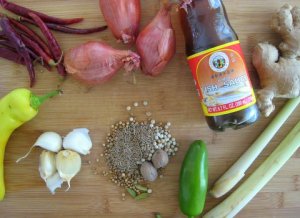
In fact, I love this so much that one may assume by the looks of my freezer that an eighty-five year old woman lives at my house. My freezer is full of little labeled bags, each one containing enough of some little morsel or ingredient to be used for a specific serving amount. Didn’t use an entire can of tomato paste or chipotle chiles? Just divide the rest up and put it in a little bag, I say! Who doesn’t love stretching one dollar across four meals?! If only I exercised this level of mindfulness and precision with my laundry or, I don’t know, our budget.
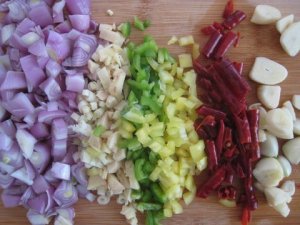
Back to making things from scratch; I’ve been really into this lately. The discovery of very inexpensive spices that can be found at international markets (basically any place that sells food outside of your conventional chain grocery store) opens up a new world of possibilities in this realm. I’ve always been a relative purist in terms of cooking meals from scratch; I keep it simple and fresh with veggies, grains, meats and bread. Now I’m moving on to condiments. I have big plans for some Guiness mustard, a fantastic worsteshire sauce, Harissa paste and maybe ketsup. Once you deconstruct a sauce or flavor component that you use regularly and typically pick up at the store, you discover that the ingredients in a store bought item tend towards fillers and artificial ingredients that diminish flavor and aren’t really good for you. Homemade marinara or Bolognese sauce, for instance, is a revelation after years of stuff from a jar.
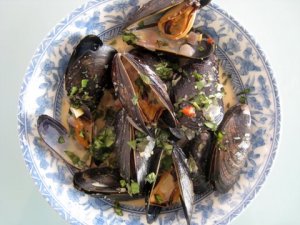
Anyway, I started this journey with Thai Red Curry paste. The beauty of Thai Red Curry paste (aside from the fact that it is utterly delicious) is that it has so many uses: stir a little into noodles, add some to rice, slather on meat for a marinade, whisk some into soup, add to oil and vinegar for a unique salad dressing… Having some of this curry paste on hand means that a can of coconut milk, shallots, lime and a pound of mussels is all it takes to quickly put together an elegant and exotic meal. I love this! I enjoy so much the complilation of all these ingredients, coming together to make something fantastic. There may be a little extra work on the front end, but I’m so thankful when I pull my well marked baggie out of the freezer for instant flavor. This little trend has started to extend to a multitude of other genres… spice blends, jams and jellies… I’m actually dreaming of getting my hands on some veal bones to make my own demi glace this Fall.
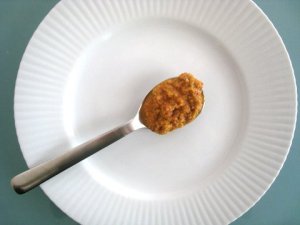
In the meantime, I’ll just share this recipe that I used from Saveur; I hope someone will try it and share with me in the unusual satisfaction that comes from a freezer full of tiny baggies.
thai red curry paste
- 8 dried chiles de arbol, stemmed and seeded
- 1 tbsp corriander seeds
- 2 tsp cumin seeds
- 1 tsp white peppercorns
- 3 cardamom pods
- 1/4 cup roughly chopped cilantro, with stems
- 2 tbsp canola oil
- 2 tbsp fish sauce
- 2 tsp kosher salt
- 1/4 tsp freshly ground nutmeg
- 5 gloves of garlic, smashed
- 3 shallots, roughly chopped
- 2 holland or fresno chiles, stemmed, seeded and chopped
- 2 stalks of lemongrass, tough outer layers discarded, tender interior layers finely chopped
- 1 one inch piece of ginger peeled and roughly chopped
- break the chiles de arbol into pieces, transfer to a small bowl, and cover with one cup of boiling water; let them soak until softened – about 20 minutes
- meanwhile, add corriander, cumin, peppercorns, and cardamom to a small skillet over meadium head; toast spices, swirling constantly, until very fragrant – about 4 minutes
- transfer spices to a grinder (I use an electric coffee grinder) and grind to a fine poweder – set aside – (if you’re feeling really rustic, you could smash and grind them with a mortar and pestle)
- strain the chiles de arbol through a sieve, reserving the soaking liquid
- in a food processor, combine chiles de arbol, ground spices, fish sauce, cilantro, oil, salt, nutmeg, garlic, shallots, fresh holland chiles, lemongrass and ginger – puree until paste is smooth, about 2 minutes (sprinkle in a tbsp or two of reserved chile soaking water to help paste grind)
- refrigerate for up to three weeks or freeze for up to three months
Thai Red Curry paste doesn’t have the flavor that many people associate with the traditional Indian Yellow Curry; the word “curry” is used in both Indian and Thai cuisines to indicate a pungeant and flavorful spice paste or mixture, and is not indicative of one specific flavor or aroma.
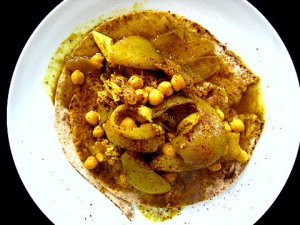 I am passionately in love with Middle Eastern cuisine. I crave it, think about it, dream about it. I search for it in every new city that we travel to. While some may be dreaming of a vacation, a new house, worrying over the economy, I am deeply pondering the best ingredient combinations for fatoush (a fantastic salad served throughout the Middle East).
I am passionately in love with Middle Eastern cuisine. I crave it, think about it, dream about it. I search for it in every new city that we travel to. While some may be dreaming of a vacation, a new house, worrying over the economy, I am deeply pondering the best ingredient combinations for fatoush (a fantastic salad served throughout the Middle East).